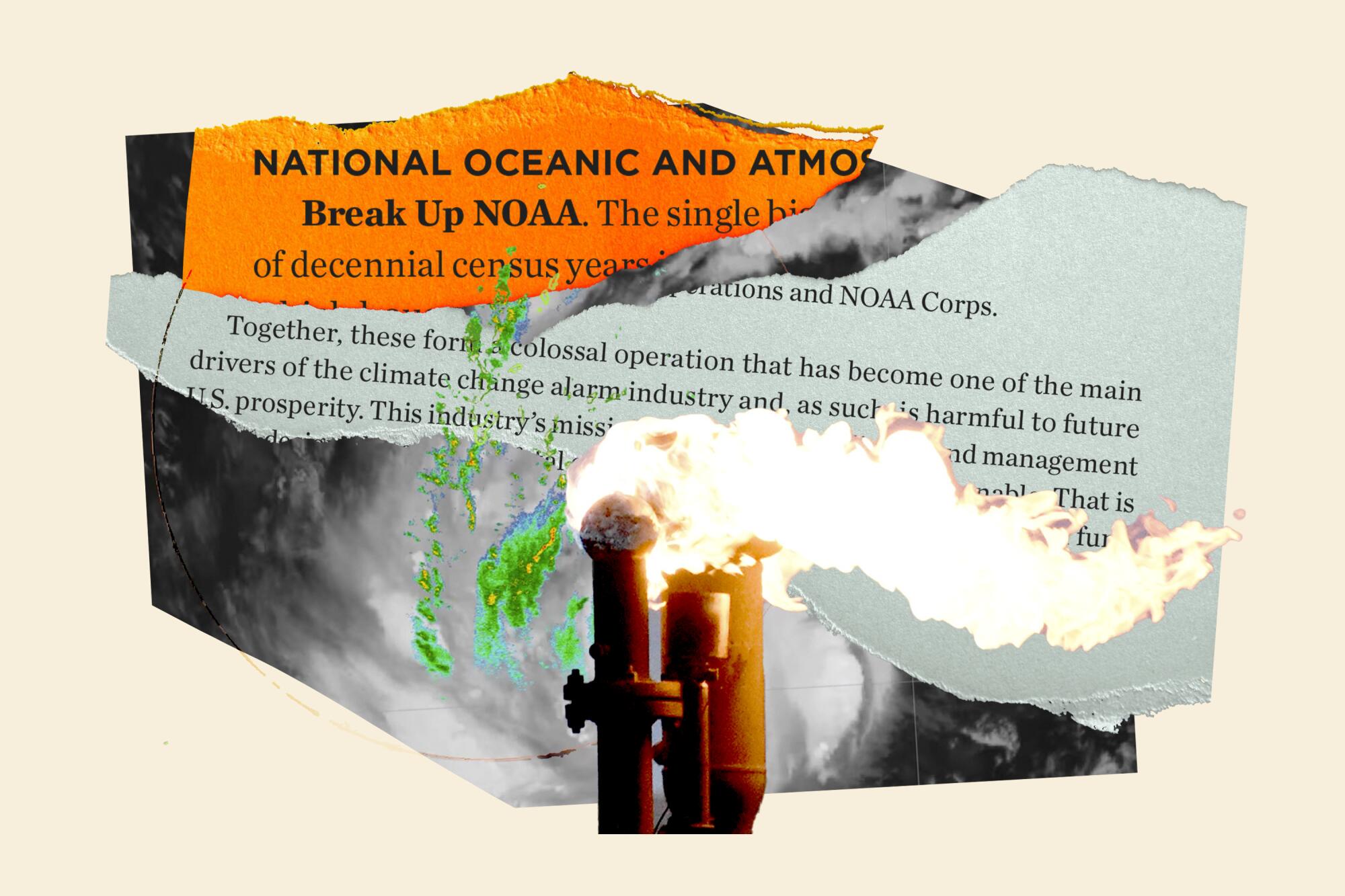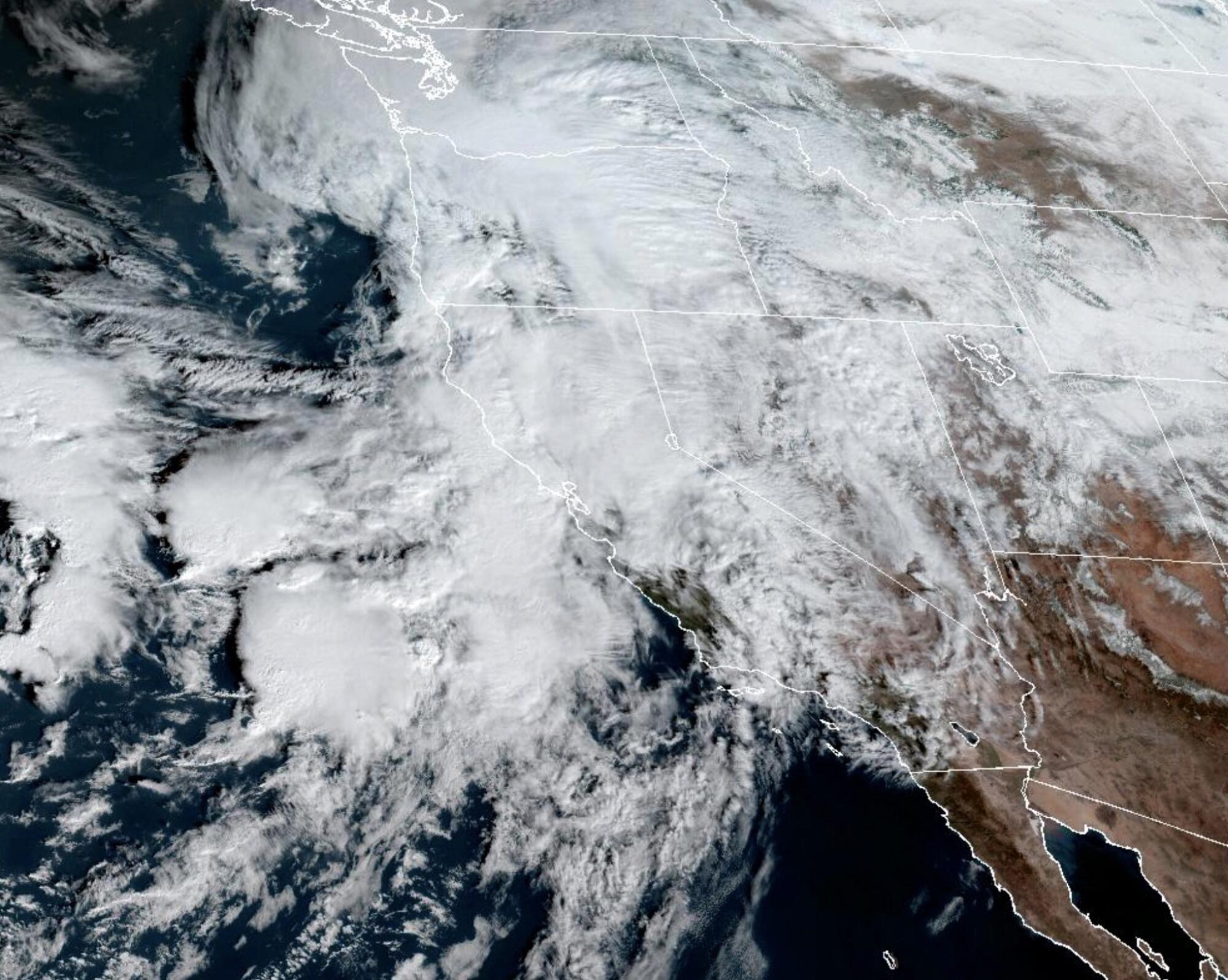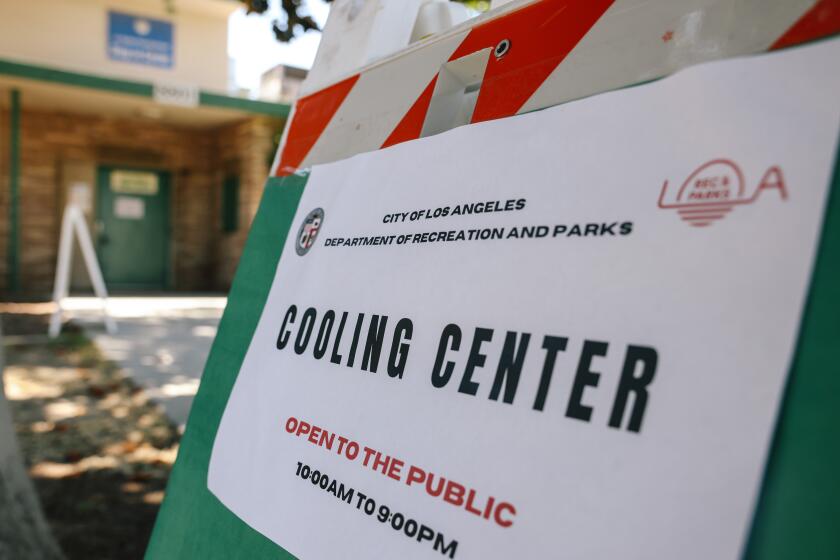
- Share via
Among its many sweeping calls for change in American government, a conservative platform document known as Project 2025 urges the demolition of some of the nation’s most dependable resources for tracking weather, combating climate change and protecting the public from environmental hazards.
“Break up NOAA,” the document says, referring to the National Oceanic and Atmospheric Administration and its six main offices, including the 154-year-old National Weather Service.
“Together, these form a colossal operation that has become one of the main drivers of the climate change alarm industry and, as such, is harmful to future U.S. prosperity,” the document says.
Aggressive and impactful reporting on climate change, the environment, health and science.
The call to dismantle a vital federal department has raised the hackles of experts who say NOAA provides not only important free data, such as weather forecasts and satellite observations, but also life-saving information about hurricanes, heat waves, atmospheric rivers and other extreme events — many of which have been shown, through myriad studies, to be worsening due to global warming.
“The National Weather Service, and NOAA more generally, is a key agency in tracking what’s happening with our climate — and in particular the ways in which humans are changing the climate,” said Matthew Sanders, a lecturer at Stanford Law School and the acting deputy director of the Environmental Law Clinic.
“To propose undercutting, breaking up and quote-unquote streamlining NOAA is really an effort to block and make less available information about climate change in order to serve an agenda of climate change denial,” he said.
The 922-page document was published by the Heritage Foundation, a conservative think tank based in Washington, D.C.
Among its arguments for dismantling NOAA are concerns about the agency’s mission as well as its size. It notes that NOAA is the largest agency under the U.S. Department of Commerce, uses about half of the department’s $12 billion annual operational budget in a typical year, and contains more than half of its personnel.
“This industry’s mission emphasis on prediction and management seems designed around the fatal conceit of planning for the unplannable,” the document says. “That is not to say NOAA is useless, but its current organization corrupts its useful functions. It should be broken up and downsized.”

The plan also states that forecasts provided by private companies such as AccuWeather are more accurate than those provided by the National Weather Service, and so it recommends that the NWS “fully commercialize its forecasting operations,” or enter partnerships to sell its data.
In a statement, AccuWeather’s chief executive Steven R. Smith said the company has not suggested that the NWS commercialize its operations, nor does it agree with the view outlined in the plan. AccuWeather relies on NOAA’s weather data as one of 190 sources in its forecast engine, and also partners with NOAA and dozens of other government agencies to share life-saving weather alerts with the public, Smith said.
“AccuWeather is extremely proud of our track record of superior accuracy, but it has never been our goal to take over the provision of all weather information,” he said.
Harris, a Californian who calls climate change an ‘existential threat,’ has prioritized investments in clean energy jobs and environmental justice.
In fact, AccuWeather is only one of many agencies and research institutions that depend on NOAA’s ground instruments, satellites, balloons, weather models and forecasts to aid in their own outlooks and analyses, according to Robert Rohde, chief scientist at Berkeley Earth, a nonprofit organization focused on environmental data science.
“Lots of people rely on the information that NOAA has collected and provides, and NOAA in turn has provided one of the most comprehensive weather monitoring systems in the world,” Rohde said.
Breaking up the agency would not only be detrimental to the American public, it would also be harmful to the advancement of science, according to Rohde. Blaming NOAA for climate change alarmism is akin to wanting to “shoot the messenger,” he said.
“NOAA has been a key resource in the federal government in providing information about climate change and communicating the risks, and they do so in a very responsible way,” Rohde said. “I don’t think they hype it up — they’re not saying the world is ending. But it is a risk on the horizon that has impacts, and the world is changing, and I think we need to face that with open eyes.”
Scott Smullen, deputy director of communications with NOAA, declined to comment on Project 2025, saying “we don’t speculate on what might or might not happen with the agency.”

The section of Project 2025 pertaining to NOAA was authored by Thomas Gilman, who served as assistant secretary of commerce and chief financial officer of the U.S. Department of Commerce during Donald Trump’s presidential administration.
Prior to that appointment, Gilman was chief executive of Chrysler Financial and spent more than four decades in the global automotive industry, a sector closely tied to oil and gas interests. Gilman is currently director of ACLJ Action, an advocacy organization “dedicated to liberty, constitutional government and religious freedom,” according to its website. He is also chairman of Torngat Metals, a rare earth development company.
The Heritage Foundation did not respond to a request to speak with Gilman for this article.
In recent weeks, Trump has distanced himself from the plan — stating on social media that he knows nothing about Project 2025 and that he has “no idea who is behind it.”
However, the plan includes contributions from other members of his Republican administration, including former budget director Russell Vought; former deputy chief of staff Rick Dearborn; former Housing and Urban Development Secretary Ben Carson; and former chief of staff of the U.S. Environmental Protection Agency, Mandy Gunasekara. Trump’s name is mentioned in the document more than 300 times.
It doesn’t matter which conservative playbook you consult. A second Trump term would mean federal war on California ideas.
Project 2025 isn’t solely focused on weather. Its sweeping recommendations include plans to restrict abortion and contraceptives, cut social security, outlaw pornography, end marriage equality, end student loan relief efforts and eliminate other federal agencies such as the Department of Education.
On the environment, it calls for increased Arctic drilling, the deregulation of the oil industry, the repeal of the Inflation Reduction Act — President Biden’s landmark climate legislation — and withdrawal from the Paris climate agreement, among other recommendations.
Rohde, of Berkeley Earth, said moving away from international goals to reduce fossil fuel emissions “will necessarily lead to more carbon dioxide in the atmosphere and higher temperatures in the future.” The planet just recorded its hottest-ever daily global temperature, and has experienced a record 12 consecutive months of warming above 1.5 degrees Celsius, an international limit established under the Paris agreement.
Rohde also cautioned that privatizing or commercializing NOAA would lead to less available data for scientific researchers. Such outcomes have already been seen in other countries that have tried similar models, such as France, which only recently committed to making more of its weather archives public, he said.
“You really talk about throwing away the baby with the bathwater if you cut off the access to those measurement programs and those monitoring programs by making them commercial so that only a few organizations will have them,” he said.

Project 2025 also calls for the repeal of the U.S. Department of the Interior’s America the Beautiful Initiative. That plan, sometimes referred to as 30x30, seeks to conserve at least 30% of the U.S.’s land and waters by 2030, and has been hailed by environmental groups as a critical step for reversing habitat and species loss and ensuring access to nature for future generations.
Project 2025 says the initiative is being used to “advance an agenda to close vast areas of the ocean to commercial activities, including fishing, while rapidly advancing offshore wind energy development to the detriment of fisheries and other existing ocean-based industries.”
But the 30x30 initiative builds on existing legal authorities to achieve the benefits of conservation, including prudent efforts to avoid over-extracting land and water resources, according to Sanders, of Stanford, who also served as an attorney in the U.S. Department of Justice’s environment and natural resources division. Withdrawing from such an effort is “not a good idea,” he said.
“I think we find that every time we use one of these authorities to set aside an area for conservation, whether on a short-term or a longer-term basis, we look back at that decision as being enlightened, meaning that it was an exercise in wisdom to promote benefits that benefit humanity long term,” Sanders said.
Earth has experienced 12 consecutive months of warming at or above 1.5 degrees Celsius — a threshold for avoiding the worst effects of climate change.
Those conservation efforts, as well as the services provided by NOAA and the NWS, are deeply familiar to most Californians.
The agency is often the first to foresee potentially dangerous events — such as atmospheric rivers, extreme heat waves, fire weather conditions or even a rare West Coast hurricane — and disseminate information to the public.
And while Trump has publicly shied away from Project 2025, the former president’s first administration included efforts to roll back more than 100 environmental regulations and pare down the functions of some federal agencies. Trump also appointed climate change deniers to senior posts in the Department of the Interior, the EPA and other departments.
Many Californians may recall a tense 2020 exchange between Trump and Wade Crowfoot, the state’s natural resources secretary, over explosive wildfires and record-breaking temperatures that plagued the state that year.
“It’ll start getting cooler — you just watch,” Trump told Crowfoot at the time.
“I wish science agreed with you,” Crowfoot countered.
“I don’t think science knows,” Trump said.
To break up NOAA and dismantle the National Weather Service would be like a return to those years “on steroids,” Sanders said, as such efforts would severely hamper the federal government’s ability to understand or take action on climate change.
It would also shift the onus of gathering and distributing critical climate and weather information onto state and local agencies, who are not singularly equipped to handle the magnitude of the challenge.
“That’s inherently less efficient and that handicaps informed decision-making — particularly when you’re dealing with something like climate change, which is not a local issue,” Sanders said. “It has local impacts, but it’s a national and international issue, so you need agencies that have the resources and the focus of tracking that kind of problem at a more national level.”
Toward a more sustainable California
Get Boiling Point, our newsletter exploring climate change, energy and the environment, and become part of the conversation — and the solution.
You may occasionally receive promotional content from the Los Angeles Times.











